CH 13 PPT (copy)
Chapter 13: The Lymphatic System and Body Defenses
13.1 The Lymphatic System - fight infection, immunity.
Components of the lymphatic system: Made up of lymphatic vessels and lymphatic organs.
Functions:
Fluid balance: Takes up excess tissue fluid and returns it to the bloodstream.
Fat absorption: Absorbs fats from the digestive tract through lacteals and transports them into the bloodstream. Aids fluid balance.
Defense: Works with the immune system to protect against disease.
B and T Lymphocytes are the main cells of the lymphatic system
13.2 Lymphatic Vessels
Structure: Forms a one-way system starting with lymphatic capillaries.
Lymphatic capillaries are tiny, closed-ended vessels that take up excess tissue fluid (lymph).
Ducts:
Thoracic duct (drains most of the body): Drains the left side of the head, left chest, left arm, and lower body into the left subclavian vein.
Right lymphatic duct: Drains the right side of the head, right chest, and right arm into the right subclavian vein.
Valves: Valves prevent backflow; lymph movement is dependent on skeletal muscle contractions.
Edema: Localized swelling resulting from the accumulation of lymph.
Key Structures in the Lymphatic System
Tonsils: Patches of lymphatic tissue that prevent pathogen entry through the nose and mouth.
Axillary lymph nodes: Located in the underarm; cleanse lymph and alert the immune system.
Thymus: Site where T lymphocytes mature and distinguish self from Non self. Shrink as a person gets older.
Spleen: Cleanses blood responds to antigens, and contains lymphocytes.
Inguinal lymph nodes: Located in the groin; cleanse lymph and alert the immune system.
13.3 Organs, Tissues, and Cells of the Immune System
Overview of the immune system: A network of lymphatic organs, tissues, cells, and their products, providing immunity (ability to react to antigens and prevent disease).
Neutrophil (40-70%) | 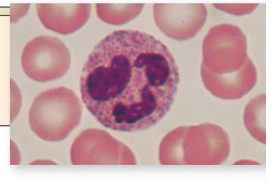 |
Eosinophil (1 - 4%) | 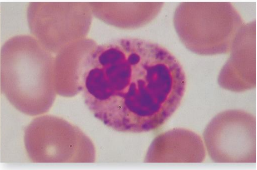 |
Basophil (0 - 1%) | 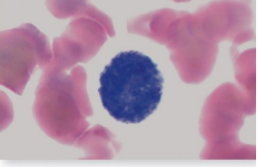 |
Lymphocyte (20-45%) | 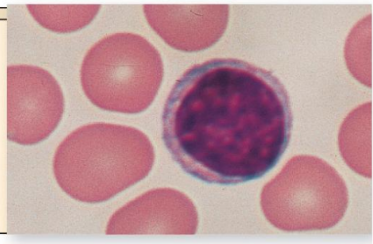 |
Monocyte (4-8%) |  |
13.4 Primary Lymphatic Organs
Major primary lymphatic organs:
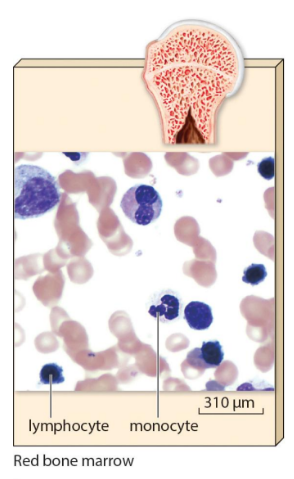
Red bone marrow: Site for the origin and maturation of blood cells; produces B a Location of red bone marrow: Found in sternum, vertebrae, ribs, skull, pelvic girdle, and proximal humerus and femur.nd T lymphocytes.
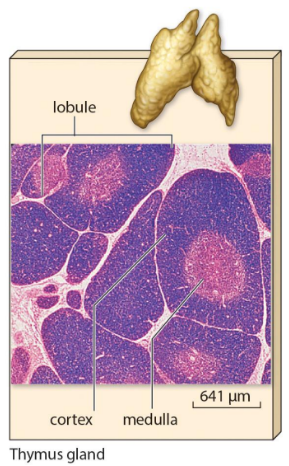
Thymus gland: In the thoracic cavity, largest in children; produces thymosins that aid T lymphocyte maturation.
Cell mediated immunity
White Pulp
Red Pulp
13.5 Secondary Lymphatic Organs
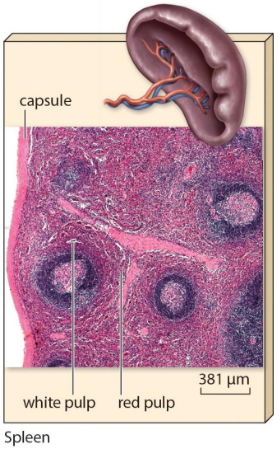
Spleen: Largest lymphatic organ, composed of white pulp (lymphocyte concentration) and red pulp (filters blood).

Lymph nodes: Small structures along lymphatic vessels, essential for immune response and filtering lymph.
Lymphatic nodules: Concentrations of lymphatic tissue no capsules, like tonsils and Peyer patches, found in areas exposed to pathogens.
13.6 The Lymphatic System and Illness
Conditions:
Lymphadenitis: Infection in lymph nodes.
Lymphangitis: Infection in lymph vessels.
Edema and lymphedema: Accumulation of lymph causing swelling.
Elephantiasis: Parasitic infection affecting lymphatic vessels.
Lymphoma: Cancer of lymphatic tissue.
13.7 Nonspecific and Specific Defenses
Immunity types: Nonspecific defenses (physical/chemical barriers, inflammatory response) and specific defenses (targeted response to pathogens).
Nonspecific defenses include: Mech. barriers (skin, mucous), inflammatory reaction, phagocytes, natural killer cells, and protective proteins (complement and interferon).
Specific defenses: Involve lymphocyte activation and response to antigens.
Three Lines of Defense
Defenses | Type | How They Work |
First Line | Mechanical | |
Second Line | ||
Third Line |
Clonal Selection Theory- the process by which specific B cells or T cells are activated and proliferate in response to an antigen, resulting in a tailored immune response.
Plasma cells undergo apoptosis when infection is gone. autoimmune disorder results in these cells mistakenly attacking healthy tissue.
Antibodies: y shaped consists of heavy and light chains
Hemoglobin Types
A - breast milk secretion
E - Surface of mast cell
D - surface of the B Cell
M - Big First produced cannot pass the placenta
G - Produced after M, big can pass the placenta
Process:
Antigen presenting cells that present antigens on its surface to other immune cells. Connected to the plasma membrane of the cell the antigen binds to major histocompatibility complex (MHC). Human - HLA - Human leukocyte antigens
Cytotoxic Cell- cell produce toxins to destroy antigen or bacterial cells
CD4 - Help increase immune response - Common in those with HIV
Interferon and Interleukins
13.8 Active and Passive Immunity
Active immunity: Person produces their own antibodies (natural through infection or artificial via vaccines).
Passive immunity: Temporary immunity from receiving antibodies from another source (natural through mothers placenta or breast milk. Hemoglobin A. artificial via gamma globulin injections).
monoclonal Antibodies - antibodies derived from the same B cell. they all bind only one antigen.
13.9 Introduction to Hypersensitivity Reactions
Overview: Allergies, tissue rejection, autoimmune diseases, and immune deficiencies.
Two Types:
IgE - Mediated Allergic - binds to hemoglobin A - causes the release of histamine and other inflammatory mediators from mast cells, leading to symptoms such as itching, swelling, and bronchoconstriction. Hay fever, Asthma, Anaphylactic Shock
T Cell - stimulate T cell produce swelling - and inflammation through the activation of other immune cells, which can exacerbate allergic reactions and contribute to tissue damage. Such as poison ivy contact dermatitis
Tissue Rejection: transplant tissue is not recognized by the body as “self” Cytotoxic T cell form antibodies against donor tissue cell
Autoimmune Disease - myasthenia gravis, multiple sclerosis, systemic lupus erythematosus, rheumatoid arthritis, type 1 diabetes
Immune Deficiency -
Immune system is unable to protect the body from disease, can be acquired or genetic, can be fatal. AIDS Acute, Chronic, AIDS. SCID
13.10 Effects of Aging on the Immune System
Aging effects: Increased susceptibility to infections, decreased T cells from thymus degeneration, issues with B cell cloning, and reduced vaccine response. Antibodies do not function well Higher chance of autoimmune disease
13.11 Homeostasis and the Immune System
Homeostasis functions: The lymphatic system supports digestion, cardiovascular functions, and immune protection. The immune system interacts with the nervous and endocrine systems to maintain balance.
 Knowt
Knowt